Looking for the best temperature worksheets on the internet? Look no further! Our temperature worksheets are perfect for helping students learn about temperatures, thermometers and converting Fahrenheit. With our free temperature worksheets, you can be sure that your students gain a full understanding of temperature concepts before they move onto more difficult topics. Our worksheets feature images and diagrams of thermometers to help students visualize the concept of temperature while they practice using a variety of formulas. We also include detailed explanations and clear examples of how to use formulas in converting Fahrenheit to Celsius. We're sure our temperature worksheets will make learning about this topic easy for your students!
Browse Sheets By Problem Type
×
Reading a Thermometer
Link
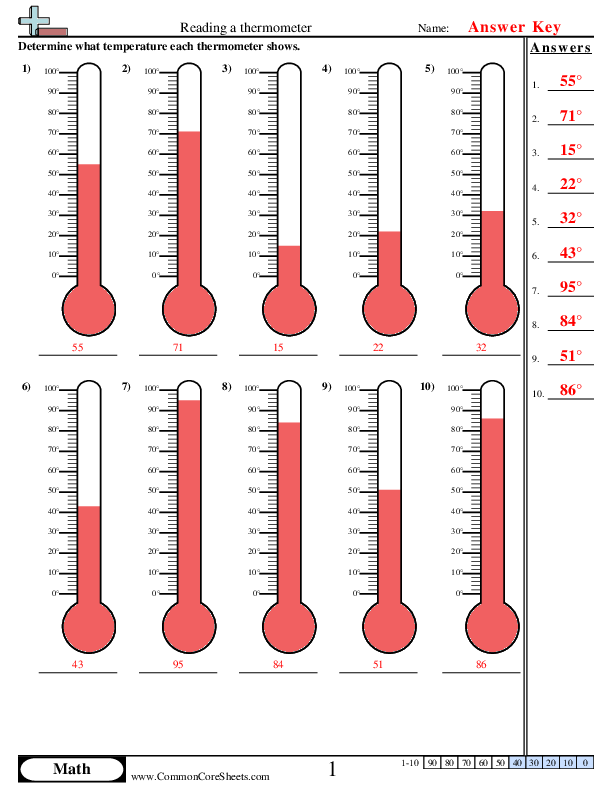
0° - 100° (10s labeled)


×
Description:
"This worksheet is designed to teach children about reading a thermometer through practical math problems. It includes 10 problems that provide real-world temperature readings between 0° and 100°. Each problem can be customized, converted into flashcards, or utilized in distance learning environments to make math fun and engaging while teaching critical weather-related concepts."

×
Student Goals:
Understanding of Basic ThermometryBy completing this worksheet, students should be able to gain a foundational understanding of how thermometers work. They will learn to interpret the scales and markings, understanding that these represent specific degrees of temperature. This understanding should extend to recognizing the demarcations and their implications, including the interpretation of the measurements represented by the thermometer.Grasp of Quantitative MeasurementQuantitative measurements are a critical part of many science and math concepts. Through this worksheet, students should learn to appreciate and understand the nature of numerical data and what measurements represent in real-world contexts. This understanding can form a basis for more complex scientific quantity-based concepts later on.Application of Practiced SkillsThe hands-on nature of this worksheet means students are not just learning about thermometer readings in the abstract, but actively practicing this skill. This repeated practice should enable them to become proficient in interpreting thermometer readings, a skill which can be applied in a variety of practical and academic contexts.Development of Observation SkillsStudents should demonstrate enhanced observational skills upon completion of the worksheet. Accurately reading a thermometer requires careful observation and attention to detail, both being critical skills applicable in a wide range of situations, both academic and real-world.Ability to Solve Temperature-Related ProblemsBeyond simply reading the thermometer, students should be able to apply the knowledge and skills gained to solve problems requiring temperature data. They should be able to extract temperature data based on thermometer readings and put this data into the correct context, whether it be a mathematical equation, a scientific experiment, or real-world scenario.


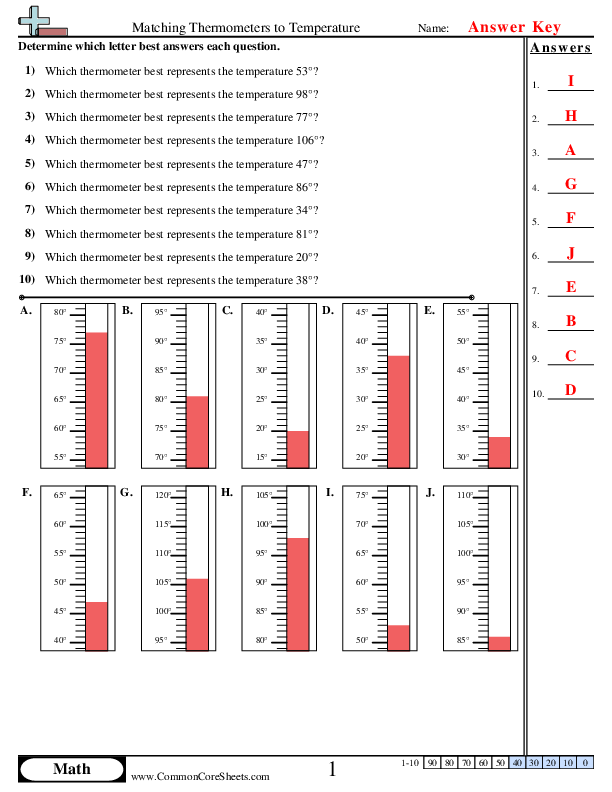
Matching Thermometers


×
Description:
"This worksheet is designed to help children learn temperature readings in a fun, interactive way. Through math-based exercises, such as matching a thermometer to the correct temperature, kids develop their understanding of weather and science concepts. This customizable worksheet, which can be converted into flashcards or used for distance learning, contains ten problems to ensure hands-on, practical learning opportunities in a digestible format."

×
Student Goals:
Understanding of Temperature MeasurementsUpon completion of the worksheet, students should have a deeper understanding of temperature measurements and how they correspond with various thermometer readings. They should be capable of accurately recognizing and interpreting the temperature on different types of thermometers, which is a fundamental skill in math as well as in everyday life situations.Enhancement of Problem-Solving AbilitiesThis exercise aims to improve the students' problem-solving abilities. Choosing the correct thermometer that represents a certain temperature requires careful analysis and critical thinking. By practicing this skill, they reinforce their ability to analyze a problem and identify the correct solution.Reinforce Math LearningsWhile the worksheet focuses on temperature reading, it indirectly includes numerical comprehension which is a pivotal element of mathematics. Students will be exposed to a range of numbers and must comprehend and compare these figures to find the appropriate match. This reinforces their overall mathematical abilities and understandings.Introduction to ThermodynamicsThis worksheet can potentially serve as a practical application and introduction to thermodynamics. The ability to recognize temperature can provide a basis for understanding the concepts of heat transfer and energy conversion in subsequent science subjects.Development of Precision and Attention to DetailSuccessfully completing this worksheet will illustrate the student's ability to pay attention to detail. Recognizing slight differences in temperature readings on the thermometers instills preciseness and careful observation. This builds an important character trait that is beneficial in broader study disciplines and life in general.Building Confidence in Individual AbilitiesThis worksheet is designed to increase student confidence in their individual abilities. Successfully identifying and matching thermometers to temperatures proves their capacity to understand complex concepts on their own. It heightens their self-confidence which can improve performance in other areas of their education.Demonstrating Knowledge ApplicationStudents will be able to demonstrate the application of their knowledge through this exercise. It's one thing to learn about temperature in a theoretical manner and another to apply what has been learned. Upon completion, the students should have proven they can successfully apply their knowledge of temperatures and thermometers to practical problems.


Finding Temperature Difference
Link

Finding Differences (With Thermometer)


×
Description:
"This worksheet is designed to help children understand temperature differences using 12 distinctive mathematical problems. It breaks down beginning, intermediate, and ending temperatures in a simplified way to facilitate learning. In addition to working the problems on the worksheet, it can be customized and converted into flashcards for a more engaging experience, making it suitable for remote and distance learning."

×
Student Goals:
Understanding of Basic Math ConceptsAfter completing this worksheet, students will have gained a solid understanding of basic mathematical concepts. They will be adept at calculating temperature differences, a practical skill that finds real-world application, thus instilling in them the relevance of math in daily life. The concept of negative numbers and their usage, particularly in temperature readings, will no longer be a confusing notion. This set of exercises will familiarize them with the number line, promoting mental math skills and quick number manipulation.Strengthening Problem Solving SkillsThe problems present in this worksheet will push students to apply their theoretical knowledge to practical scenarios. Tactical problem-solving is a crucial skill that students will nurture by figuring out temperature differences. They will need to deduce the logical approach to find the solution, thereby honing their analytical skills. From simpler problems to slightly complex ones, the gradual progression will help boost their confidence in tackling mathematical problems in general.Analytical ThinkersPost completion of the worksheet, students will display a marked improvement in their analytical thinking abilities. By decoding i.e., determining the start and end temperatures and figuring out the difference, they'll exercise their brain's analytical part. This form of thinking promotes logical reasoning, facilitating comprehension of complex mathematical concepts in the future.Attention to DetailsA successful completion of this worksheet signifies that students have been able to list out key details meticulously. In each problem, they need to pay close attention to the start and end temperatures and execute the correct operations to arrive at the right conclusion. This practice will make them detail-oriented, a trait of immense importance in all walks of life.Perseverance and ConfidenceCompleting the worksheet will demonstrate that students possess the perseverance to see a task through to the end, even if they find certain problems challenging. This resilience will instill a sense of self-efficacy and boost their confidence in their mathematical abilities, preparing them to take on more complex problems and tasks in the future.


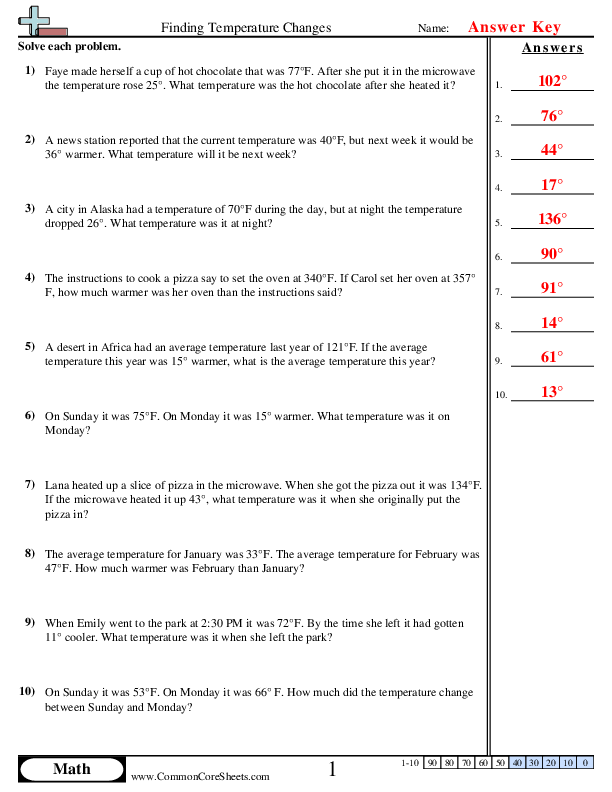
Word Problems 0° - 100° F


×
Description:
"This worksheet is designed to teach children mathematics through real-world temperature change scenarios. It reinforces concepts like addition, subtraction and difference. Featuring ten problems, set in relatable contexts like weather predictions and cooking instructions, kids enhance their critical thinking. The worksheet can be customized, converted to flash cards, or adapted for distance learning, offering versatile educational utility."

×
Student Goals:
Understanding Mathematical ConceptsAfter completing the worksheet, students should be able to understand and apply various mathematical concepts. They should be able to work with numbers critically and logically. This understanding will facilitate their decision-making skills, enabling them to solve problems effectively and arrive at logical conclusions.Measure Temperature VariationsStudents will have gained the ability to measure temperature changes. Through different problem scenarios, they should be able to compare and compute temperature variations. This knowledge is crucial not just in academics but also in everyday life situations where temperature plays a critical role.Interpret and Solve Word ProblemsThe worksheet aims to enhance the students' skills in interpreting word problems and converting them into mathematical equations. They should be able to extract essential information, identify what is being asked, and execute the appropriate calculation method to find the answer.Critical Thinking and Problem-Solving SkillsStudents should demonstrate improved critical thinking and problem-solving abilities after completing this worksheet. It encourages students to think independently, consider different angles of a scenario, and strategize the best approach to find solutions.Real Life ApplicationThe questions lay a foundation for applying mathematical knowledge to real-world scenarios. After completion, students should be able to correlate how the concepts learnt can be used in daily life, such as understanding weather patterns or managing household tasks involving temperature measurement.Confidence in Numerical ComprehensionStudents should feel more confident in their numerical comprehension capabilities. The purpose of the tasks is to cement their understanding of numbers and mathematical operations and to boost their confidence in tackling similar problems in the future.


Converting Temperatures
Link
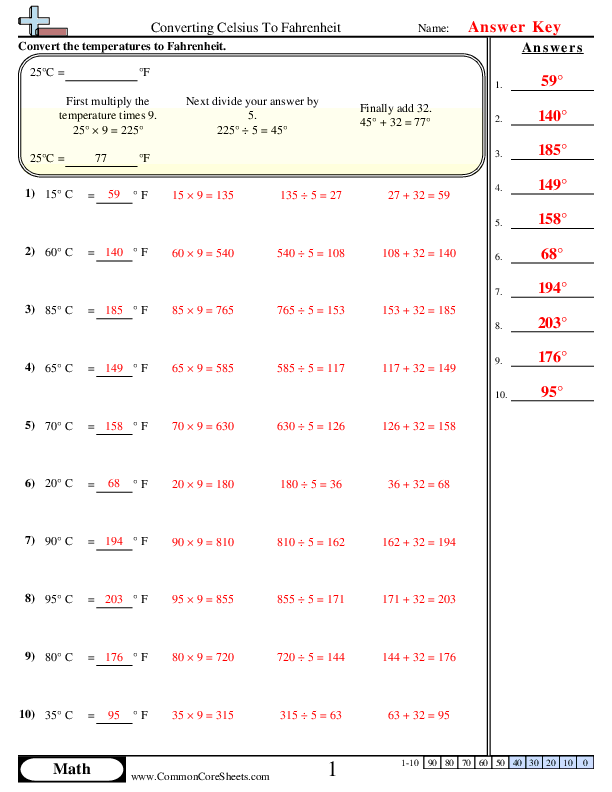
Celsius to Fahrenheit


×
Description:
"This worksheet is designed to aid children in mastering the concept of converting Celsius to Fahrenheit, explained step by step in ten math problems. Its customizable content can be adapted for different learning styles, converted into flash cards for efficient review, or integrated into distance learning curriculums, making complex math subjects kid-friendly and easier to grasp."

×
Student Goals:
Understanding of Temperature ConversionAfter successfully completing this worksheet, students should have a solid understanding of how to convert temperatures from Celsius to Fahrenheit. Grasping this conversion is a fundamental aspect within the field of mathematics, science and daily life, enhancing their ability to understand weather forecasts, bake recipes that require specific oven temperatures, or use any application that centers on these temperature metrics.Problem Solving SkillsThe worksheet boosts the problem-solving skills of the student. It privileges them with the skills to dissect a problem, identify the procedure to solve it, and then execute the plan. It will facilitate their inherent ability to analyze and breakdown complex problems into manageable bits, an essential skill in tackling both math and real-life challenges.Application of Mathematical OperationsThis exercise affirms the student's understanding of the basic mathematical operations; multiplication, division, and addition. It provides an example of how these operations are used daily beyond the classroom walls, strengthening their comprehension and application.Cognitive AbilitiesThe worksheet helps improve cognitive abilities in students. Implementing number manipulation, calculation execution, and logical reasoning enhances their brain function, attentiveness, and memory. This improvement will be reflected in other areas of learning and information processing.Enhancement of Practical Math SkillsUpon completion of this worksheet, pupils will enhance their practical math skills. The understanding of temperature conversion is applicable in many real-world scenarios and disciplines like physical sciences, engineering, and even in culinary arts. This cements their real-world application of theoretical mathematical concepts.Building ConfidenceSuccessfully doing conversions and understanding the supporting math instills confidence in students. This confidence will encourage them to take on more challenging problems and equations, not only in temperature conversions but in other mathematical areas as well. This development is crucial in their academic growth and future mathematical endeavors.


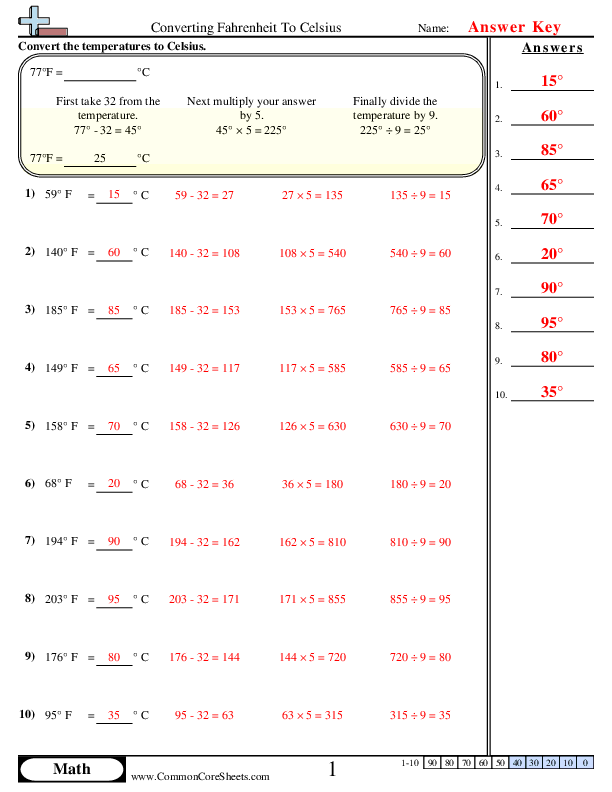
Fahrenheit to Celsius


×
Description:
"This worksheet is designed to enhance children's mathematical abilities in the specific area of temperature conversion from Fahrenheit to Celsius. It presents ten robust examples, detailing step-by-step computation from Fahrenheit to Celsius which is an essential concept in elementary math. This customizable tool can also be transformed into flashcards, or utilized for distance learning, broadening its applicability while maintaining its educational efficacy."

×
Student Goals:
Understanding Temperature ConversionUpon completing this worksheet, students should now have a clear understanding of how to convert temperatures from Fahrenheit to Celsius. They will comprehend how to successfully navigate the formula used in this conversion which includes subtracting 32 from the Fahrenheit temperature, multiplying the result by 5, and finally dividing by 9. This foundational skill is a key component of various scientific concepts and processes, extending their mathematical aptitude.Enhanced Problem Solving AbilitiesThrough the practical application of solving conversion problems, students will have boosted their problem-solving skills. They will have gained proficiency in breaking down complex problems into simple, manageable steps which is beneficial across all topics in mathematics and science. This worksheet enables them to practice and hone in on their analytical capacity, laying the groundwork for solving more intricate problems in the future.Improved Numerical ProficiencyMastering the conversion method taught in this worksheet requires fundamental operations like subtraction, multiplication, and division. Therefore, students should see a notable improvement in their numerical skills. They can manipulate and interpret numerical information with more comfort and fluency. This strengthens their overall mathematical competence, a vital skill that will be useful throughout their academic journey and beyond.Thorough Grasp of Mathematical FormulasAny observable growth in comprehending and applying mathematical formulas is another significant achievement after this worksheet exercise. Students will understand how a formula encapsulates a consistent method for solving a specific type of problem. This comfort with using formulas will support students in efficiently tackling similar problems. It transcends beyond temperature conversions, equipping them with the much-needed confidence to handle equations, expressions, and formulas across the mathematical field.Expanded Scientific KnowledgeLastly, the ability to convert temperatures between Fahrenheit and Celsius scales broadens students' understanding of scientific measurements. They will understand that different regions of the world use different temperature scales and why these conversions are crucial in universal scientific communications. It takes them one step closer to becoming global citizens by appreciating different measurement systems used worldwide.







